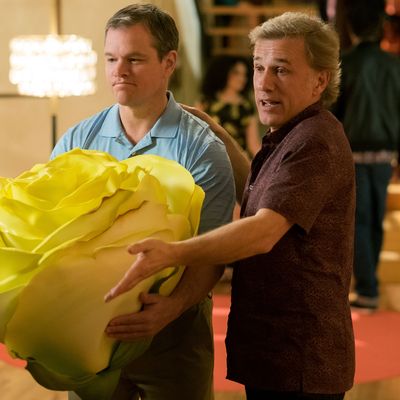
Alexander Payne’s Downsizing begins with a momentous breakthrough. A Norwegian scientist, Dr. Jørgen Asbjørnsen (Rolf Lassgård), has perfected a procedure that “downsizes” people, shrinking them down to five inches tall. Though downsizing is initially marketed as being environmentally friendly, it quickly catches on for another reason: Smaller people use less money. For instance, when Paul (Matt Damon) goes in to get a consultation, he’s told that, if he chooses to go through with the procedure, the $52,000 that he has would effectively turn into $12,500,000. That’s nothing to sniff at.
Assuming that downsizing technology could be safely developed, we wanted to know: Is Payne’s vision realistic? So we spoke to economist Ethan Pollack, associate director of research and policy for the Aspen Institute’s Future of Work Initiative, to go through Downsizing inch by inch. It turns out that the utopian vision posited by the Norwegian scientists isn’t exactly true to life. But, like the movie itself, the discrepancy between what makes sense and what doesn’t just provides further food for thought.
The idea that life will be cheaper for downsized folks is one that only extends so far. According to Pollack, what will or won’t be cheaper depends entirely on what the thing in question is. Where material goods are concerned, some would be cheaper, given the lesser amount of raw material required and reduced shipping costs — but this gets complicated when considering how much extra work would be required to make things small enough to be practical for a downsized consumer.
“For some goods,” says Pollack, “that [effort] would be minor. With food, for example, you could just take existing products and chop them up into smaller pieces.” But not everything is so easy. “Clothes, for example, will require an entirely different production process, and would initially be a niche market. Eventually if the market for small clothes grew, the cost would fall as the production process would achieve economies of scale — but in the near-term, tiny clothes would probably be quite expensive.”
The example of clothing also brings up questions of how production will change. It wouldn’t be enough to just miniaturize the production process. “Textile producers might actually need to use different materials to get the clothes to move on a miniature body the same way cotton does for full-sized humans,” says Pollack. “This may be more difficult than just switching to a new material, because cotton has been specifically bred to be a good clothing material for full-sized humans, so we might actually need to breed a new plant for small clothes.” And, again, this whole process would consume both time and money, and wouldn’t do anything to alleviate costs until such miniature clothing was mass produced.
That life post-downsizing would be cheaper is a notion also complicated by the fact that not everything we pay for is material. As Pollack puts it, “In the last 75 years or so, our economy has shifted away from goods and towards services: Services now represent over two-thirds of consumer spending, with only a third for goods.” And services — things like health care and education, which can’t exactly be shrunk — would likely not change in price, or possibly be even more expensive.
To Payne’s credit, however, the movie does get a few things right when it comes to how downsizing would affect the overall economy. Throughout the film, people complain about fluctuations in the housing market as well as in the job market due to downsizing, and it’s likely that downsizing would indeed prompt that kind of change. Smaller people would need smaller houses and, in accordance, a smaller amount of land. “The demand for land would fall,” says Pollack, “but the supply would remain the same, so the price would fall.” Where jobs are concerned, the effect of downsizing would depend on whether or not smaller people actually spend less money, which, as discussed, is an uncertain prospect. But assuming that that would indeed be the case, downsizing could actually be responsible for a recession and job loss.
Downsizing would also have an effect on the income of people who’ve undergone the procedure, with that divide between goods and services serving as a distinguishing line. “For high-skill, knowledge-economy jobs that require little-to-no physical activity, the income should remain the same,” says Pollack. “But the wages for low-skill workers would probably drop significantly. This could create massive inequality within the population of mini-humans.” This is a problem that’s only vaguely touched upon in Downsizing, as Ngoc Lan Tran (Hong Chau) reveals to Paul that there’s an entire community of downsized people who are living in squalor rather than the resplendence that Paul enjoys.
Overall, were downsizing ever to become a reality, the growing pains involved would likely be much more severe than the movie presents. There would likely be a recession and a sharp disparity between haves and have-nots in downsizing communities, and it would take a significant amount of time and effort for the economy to balance out, if not separate into different entities, period. According to Pollack, “eventually mini humans will create their own supply chains and production,” leading to a separation between normal-sized and downsized economics, “with only a few areas of trade between them.” Then there’s the matter of how this would all affect the world at large: The value of money would alter depending on how many people per country were downsizing, as well as the rate at which that change would continue. In other words, though downsizing is presented as a cure for all your ills — for monetary woes, for ennui, etc. — practically speaking, it might actually make your troubles loom larger.




